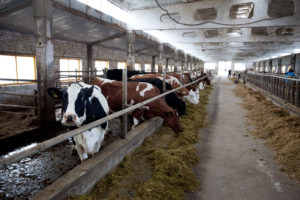Three reasons for food shortages

 PIONEER MEIZHENG BIO-TECH (5 in1) JC0586 - Antibiotic tests 5 in 1 / Rapid tests for determining the residual amount of β-lactams, tetracyclines and cephalexin in milk, whey
PIONEER MEIZHENG BIO-TECH (5 in1) JC0586 - Antibiotic tests 5 in 1 / Rapid tests for determining the residual amount of β-lactams, tetracyclines and cephalexin in milk, whey Express tests for determining the residual amount of β-lactams, tetracyclines, chloramphenicol, streptomycins in milk, whey
Express tests for determining the residual amount of β-lactams, tetracyclines, chloramphenicol, streptomycins in milk, whey
1: Fertilizer shortage
Since the conflict began in February 2022, fighting has disrupted supply chains for fertilizers, a vital source of nutrients for crops.
RUSSIA is the world's largest exporter of nitrogen fertilizers and ranks second in supplies of phosphorus and potassium fertilizers for plants. Another major fertilizer producer is Belarus , which has also come under Western sanctions . In addition, these two countries account for more than 40% of global potash fertilizer exports.
The complete list of the top 20 mineral fertilizer exporters on the planet is as follows:
The main EXPORT destinations for fertilizers from Russia are such large countries as India, Brazil , CHINA and the usa .
However, many developing countries, including Mongolia, Honduras, Cameroon, Ghana, Senegal and Guatemala, purchase at least a fifth of imported mineral additives for their agricultural sector from Russia.
In addition, as a result of hostilities, certain trends that had already led to supply disruptions have become more noticeable. Among them are increases in inventories in leading producing countries such as China, and a sharp rise in prices for natural gas, the main raw material for the production of fertilizers.
2: World grain exports
The blockade of Ukrainian ports and Western sanctions on Russia have exacerbated problems in global supply chains, triggering food and energy price inflation around the world.
This is largely due to the fact that Russia and Ukraine account for almost a third of all wheat supplies to the world market . Wheat is among the most popular crops, from which various food products such as bread and pasta are produced each year. In addition, Ukraine ranks as one of the largest exporters of corn, barley, sunflower and rapeseed oil.
As a result of the blockade, the export of grain and oilseeds from Ukraine decreased from six to two million tons per month. After two months of negotiations, both countries agreed to reopen Ukrainian Black Sea ports for grain exports, raising hopes of easing the international food crisis.
3: Recent food crises
According to the UN, about a billion people went hungry around the world last year. In addition to military actions in Ukraine , the CORONAVIRUS pandemic, climate change and some other factors are also responsible for this situation.
In 2021, the wine industry in France had its weakest harvest since 1957, with losses from reduced sales due to rising temperatures and adverse weather conditions estimated at US$2 billion. From April 2020 to December 2021, coffee prices rose 70% after drought and frost destroyed crops in Brazil.
Amid multiple crises, the World Bank recently announced up to $30 billion in financial support for ongoing and new projects in areas such as agriculture , food supply, social protection, water supply and irrigation.
Read together with it:
- The IEA sees a risk of a decline in oil production in Russia due to sanctions.The IEA sees a risk of reduced oil production in RUSSIA due to US sanctions , but maintains its production forecast. According to the IEA, Russian oil exports will remain unchanged.There is a "significant downside risk" to Russia's oil production forecast due to US sanctions, the International Energy Agency (IEA) said in a report.BLOOMBERG . The agency's experts believe that the latest US sanction...
- UniCredit заявил о галактических усилиях из-за санкций против РоссииUniCredit старается не нарушить «более 15 тыс. санкций», а также не «совершать ошибки», которые позволят изъять его активы в России, заявил гендиректор. После начала военной операции банк начал рассматривать возможность ухода Итальянский банк UniCredit прилагает «галактические усилия», пытаясь соблюсти международные санкции в отношении своего российского подразделения. Об этом заявил генеральный д...
- "Коллективы АПК способны решать любые задачи даже в непростых условиях". Назаров о заслугах сельхозпроизводителейЮрий Назаров 13 ноября, Минск. Обеспечение продовольственной безопасности страны - большое достижение трудовых коллективов аграриев, отметил управляющий делами Президента Республики Беларусь Юрий Назаров на торжественной церемонии награждения государственными и иными наградами работников АПК Управления делами Президента Республики Беларусь, передает корреспондент БЕЛТА. Торжественная церемония наг...
- "Белорусские продукты - страновой бренд". В Гродно поздравили работников сельского хозяйства областиФото 13 ноября, Гродно. В Гродно торжественно поздравили с профессиональным праздником работников сельского хозяйства, передает корреспондент БЕЛТА.Этот праздник в нынешнем году для аграрной отрасли региона особенный - впервые в истории в области собрали более 2 млн т зерна с учетом кукурузы. Как отметил в беседе с журналистами председатель комитета по сельскому хозяйству и продовольствию облиспол...
- He crawled to the icon with prayer. The true story of a man who overcame drug addiction.Alexander Ovchinnikov. Topic News. Our project's hero was a drug addict for many years. The thought that this was a dead end never left him, but his addiction proved stronger. One day, when he could no longer walk, he crawled to an icon in prayer. This became his first step toward a new life. Today, he heads a charity center that helps those who have given up hope and are unable to quit ALCOHOL an...
























































